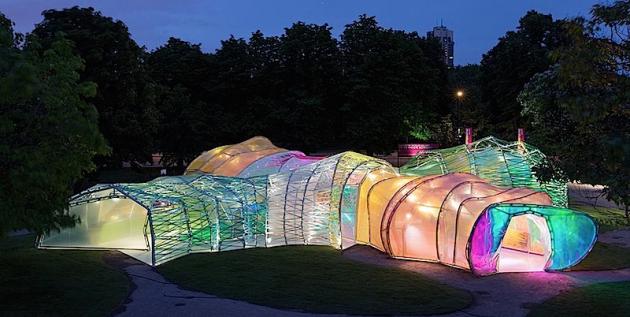The Serpentine Galleries’ world-renowned Pavilion commission designed this year by Spanish husband and wife team, architects SelgasCano has opened to the public in London. Since it was launched in fifteen years ago by Gallery Director Julia Peyton-Jones, the Serpentine Pavilion has become an international site for architectural experimentation, presenting inspirational temporary structures by some of the world’s greatest architects, including Peter Zumthor, 2011; Frank Gehry, 2008; Rem Koolhaas and Cecil Balmond, with Arup, 2006; Oscar Niemeyer, 2003; Daniel Libeskind with Arup, 2001 and Zaha Hadid, who designed the inaugural Pavilion in 2000. A much-anticipated landmark in London each summer, the Pavilion is one of the top-ten most visited architectural and design exhibitions in the world.
SelgasCano’s latest design for the highly regarded Pavilion, reveals an amorphous, double-skinned, polygonal structure consisting of panels of a translucent, multi-coloured fluorine-based polymer (ETFE) woven through and wrapped like webbing. Visitors can enter and exit the Pavilion at a number of different points, passing through a ‘secret corridor’ between the outer and inner layer of the structure and into the Pavilion’s colourful interior. The architects’ inspiration not only came from the site itself, but from the ways in which people move through London, notably the London Underground with its many-layered, chaotic yet structured flow.
The Serpentine Galleries’ Julia Peyton-Jones, Director, and Co-Director Hans Ulrich Obrist said: “We are proud to work with selgascano in this, the 15th year of a commission unique in the western world that continues to showcase some of the boldest and innovative designs in contemporary architecture internationally. In keeping with their reputation for playful designs and bold use of colour, selgascano’s design is an extraordinary chrysalis-like structure, as organic as the surrounding gardens. It is a place for people to meet in, to have coffee and to experience the live events we put on throughout the summer.”
SelgasCano, architects of the 15th Serpentine Pavilion said: “When the Serpentine invited us to design the Pavilion, we began to think about what the structure needed to provide and what materials should be used in a Royal Park in London. These questions, mixed with our own architectural interests and the knowledge that the design needs to connect with nature and feel part of the landscape, provided us with a concept based on pure visitor experience. We sought a way to allow the public to experience architecture through simple elements: structure, light, transparency, shadows, lightness, form, sensitivity, change, surprise, colour and materials. We have therefore designed a Pavilion which incorporates all of these elements. The spatial qualities of the Pavilion only unfold when accessing the structure and being immersed within it. Each entrance allows for a specific journey through the space, characterised by colour, light and irregular shapes with surprising volumes. This is accomplished by creating a double-layered shell, made of opaque and translucent fluorinebased plastic (ETFE) in a variety of colours.
At the heart of the Pavilion is an open space for gathering as well as a café. We are also very much aware of the Pavilion’s anniversary in our design for the 15th annual commission. The structure therefore had to be – without resembling previous Pavilions – a tribute to them all and a homage to all the stories told within those designs.”

